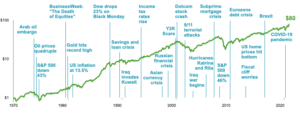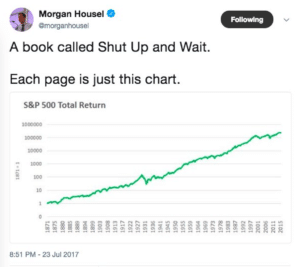Should you be thinking about selling your investments in the stock market? I’m hearing this question more and more lately. It’s a natural question and a normal response in times of turmoil and stress. A client asked me that question earlier this week. He’s understandably concerned about what’s happening.
This was my response:

Yes, I was trying to provide some comic relief to a serious and stressful situation. But I was also being sincere. My message is to hold the line. Keep your wits about you. Stay focused on the things you can control.
That’s not to say it’s easy. Since the start of 2022, the S&P 500—what most refer to as “the market”—is down over 10%. Inflation is surging and interest rates are on the rise. America’s debt keeps growing. To make matters worse, Russia just invaded Ukraine—sparking worries of a massive global conflict. There are a lot of unknowns and many things to be concerned about.
So why would my response be to hold the line? Let’s break it down.
First, let’s highlight the situations where you would sell:
- You need the money. You sell investments to create cash to pay for normal living expenses or a vacation. This is common for people in retirement.
- Your goals changed. You’re saving and investing for a house, but then you decide you’re going to start a business instead.
- You’re rebalancing your portfolio. The US stock portion of your portfolio has grown a lot over the last several years. You decide to take some “chips off the table” by selling some stocks in the US market and buying more shares in the European market. Buy low, sell high as they say.
Notice that none of these reasons have anything to do with outside events or market anxiety. Fear tempts us to sell. I understand the reaction. When we feel backed against the wall we tend to grasp for control. This can sometimes lead to wanting to do something—anything. Pair that with the hyperbolic news headlines and it’s enough to make anyone go crazy. It’s also going to make you want to tinker with your portfolio. We tend to think things like, I’ll just get out now and wait until things calm down. If that thought crosses your mind use these two questions as a defense:
- How do I know when to get out?
- How do I know when to get back in?
If you can answer those questions with any level of confidence or precision then go for it. Otherwise, I’d recommend sticking to your long-term investment plan. I understand it’s easy to agree with things like, “stay the course” or “focus on the long term” when times are good. But when the world feels like it’s unraveling, it’s a little harder to maintain a calm mind and a rational approach. It’s difficult but that’s exactly what you need to do—keep your head.
Stay Calm and Zoom Out
Here’s the growth of one dollar invested in the MSCI World Index from 1970 to 2020:

This time period includes the crash of 1987, the dotcom catastrophe, and the “great recession” of 2008-2009. Oh, there was also this thing called Covid. A lot of reasons to freak out. Still, if you had stayed the course you would’ve multiplied your investment by eighty times.
This is why I agree with David Booth when he said,
“The most important part of any investment philosophy is having one you can stick with.”
Right now it’s inflation, Russia, and the Fed. Then it’ll be something else. There will always be short-term worries that rock the markets. But people keep waking up looking to improve their lives. Billions of us keep building careers and businesses to make more money for ourselves, our families, and our communities. And as a result, the markets keep moving up over time. Until the drive for progress and innovation dies, the markets will charge on—no matter what unrest comes our way. If you zoom out far enough, you’ll realize the market goes up. It just doesn’t do it in a predictable or linear fashion.
This is Normal
Since 1928, the S&P has had a decline of 30% or more 12 times. That’s an average of once every eight years. A drop of at least 20% has happened 20 times. That’s an average of once every five years. A drop of 10% happens as often as Christmas. These drops are normal. They are the cost of your investments growing while you sleep. You cannot expect a reward in the long run without the risks in the short run. The relationship between risk and reward is what makes the market function. They cannot be separated from one another. Just like you can’t expect to build strength without the pain of lifting weights, you can’t expect to build wealth without the heartache that comes from the ups and downs of the market.
In times like these, it’s important to remember legendary investor Peter Lynch when he said,
“Far more money has been lost by investors preparing for corrections or trying to anticipate corrections than has been lost in the corrections themselves.”
I know it’s easier said than done. But it simply doesn’t make sense to sell investments when markets are down. In fact, you should be doing the opposite. Try to look at the market drops as stocks going on sale. That’s exactly what’s happening. If you are saving money into your investment accounts monthly then the drawdowns are a good thing. Drawdowns in the market shouldn’t be looked at as obstacles to wealth—they are opportunities. This is where money is made.
One of my all-time favorite tweets from my all-time favorite financial writer, Morgan Housel, sums it up perfectly:

It’s important to remember why you’re investing in the first place. Do you need the money right now? If not, then it shouldn’t matter where it’s valued today. You only lose if you sell. The only reason you’d sell would be based on reasons personal to you, not because the market is scary. Above all else, try to remember that time in the market will always beat trying to time the market.
Here’s to making money matter!

